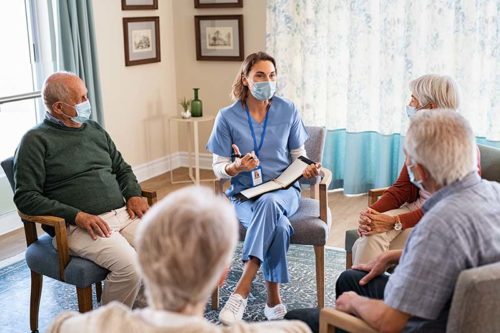The global pandemic exposed a need to elevate the standard of care for the elderly. In particular, senior citizens living and spending time in group settings such as nursing homes, residential care facilities, and senior centers were at exceptionally high risk for contracting and dying of COVID-19.
As of April 2021, the U.S. Department of Energy reported that residents in long-term care facilities accounted for only 3% of the total 21 million confirmed COVID-19 cases in the U.S., yet made up one-third of the 350,000 deaths. Nursing home residents are particularly susceptible to COVID, and other infections, due to their naturally lowered immune functions and being prone to pre-existing conditions. Additionally, nursing homes lack the systems engineered to control the spread of potentially life-threatening contagious diseases, like COVID.
Various tactics are needed to prevent the spread of infections where older adults live and congregate. Fortunately, armed with some vital information, facilities can take steps to protect their communities better.
The Role of Ventilation And Filtration
Similar to other contagious pathogens, it became evident that COVID spreads primarily indoors. Beyond physical distancing and masking, the best way to reduce the spread is by implementing air ventilation and filtration systems.
According to the Journal of the American Medical Association (JAMA), “The weight of evidence indicates ventilation plays a key role in infectious disease transmission, (…) showing low ventilation associated with transmission of measles, tuberculosis, rhinovirus, influenza, and SARS-CoV-1.”
Elevate Ventilation Standards
Yet, JAMA also reports that most indoor spaces (except for hospitals) ventilate and filter air at minimum levels.
The American Society of Heating, Refrigeration, and Air Conditioning Engineers (ASHRAE) sets ventilation standards for most indoor spaces. However, these standards are intended to remove odors and ensure an adequate level of air quality. They don’t support an infection control strategy.
Better Filtration Plays A Key Role
MERV FILTERS
Air filters and purifiers have several efficiency standards, including clean air delivery rate (CADR) and minimum efficiency reporting value (MERV). Established by ASHRAE, the MERV rating measures the quality of air filters used in central ventilation systems. For reference, MERV-8 is a typical low-grade filter that captures only 15% of small particles. MERV-13 filters are able to capture nearly 70% of small air particles and are an integral part of a larger infection control program. Standards for nursing home resident rooms require only MERV-7 filters.
HEPA FILTERS
HEPA filters are used in any application that requires contamination control. Air purifiers equipped with HEPA filters can capture even smaller microns than MERV filters. Since they reduce the number of particles that carry viruses by approximately 95%, they are considered medical grade.
Upgrading filters to capture a higher percentage of particles of all sizes is a reasonably simple way to protect the elderly living in long-term care facilities.
Incorporate Fresh Air
Researchers have found that fresh air delivered through AC or ventilation systems plays an important role in diluting the volume of viral aerosol particles in a room. Monitoring carbon dioxide (CO₂) levels is a simple way to ensure enough fresh air is in a room, as high CO₂ levels indicate that there is a lot of exhaled air in the room. A sick person has a greater chance of distributing viral particles to a healthy person.
Relative Humidity Matters, Too
In addition to regular ventilation and air filtration, the International Journal of Environmental Research and Public Health recommends maintaining relative humidity (RH) levels between 40-60% for two reasons. First, mucous membranes are most resistant to infection in moderate humidity levels. Second, aerosol particles potentially containing contagious diseases can live for less time at 50% RH than in drier or very humid conditions.
Facilities and residences for older people can monitor humidity and utilize humidifiers as needed at a low cost.
The Bottom Line
A multi-pronged approach is the best way to protect older citizens from low-quality air and infectious diseases. Fortunately, a highly effective solution can be as simple and unobtrusive as a window AC unit.
Air Innovations brought over 25 years of experience designing and manufacturing customized solutions for temperature, humidity, and filtration control to its HEPAiRx® ventilating and filtrating system. HEPAiRx systems are air filtration devices that are comparable in size to a standard AC unit. They combine multiple strategies for maintaining optimal health in a variety of applications. HEPAiRx units quickly and thoroughly purify a room of airborne particles and contaminants. Each plug-and-play unit features a MERV-17 medical-grade HEPA filter and ventilation to exhaust air for a standard-sized room every 30 minutes.
HEPAiRx systems are an ideal solution for use in nursing homes. Since each unit is entirely self-contained and compact, facilities don’t have to overhaul their existing HVAC systems. HEPAirX units empower facility administrators to take a proactive approach to keep our beloved older family members and staff safe and healthy.
The HEPAiRx system is currently the only solution on the market that can do the following:
- Bring dedicated fresh air into a room to naturally dilute potentially harmful aerosol particles, VOCs, and gases.
- Create either a negative or positive pressure environment.
- Use optional upstream UV-C to kill viruses trapped on the intake side of the HEPA filter – the only effective way to kill viruses on the HEPA filter.
- Integrate the HVAC to isolate the space from the existing systems. HVAC ductwork is a source of cross-contamination between operatories. When using the HEPAiRx system, you can seal off the existing system to separate it from adjacent rooms, creating an actual isolation space.

